I'm newbie in D3.js. I would like to make many graphs on one page as here http://bl.ocks.org/d3noob/5987480 based on this example https://bl.ocks.org/mbostock/1166403

But I ran into a problem. The scale in the first chart is incorrect. And I just don't understand, why... How to fix this?
<!DOCTYPE html>
<meta charset="utf-8">
<style>
svg {
font: 12px Arial;
}
path.line {
fill: none;
stroke: #666;
stroke-width: 1.5px;
}
path.area {
fill: #e7e7e7;
}
.axis {
shape-rendering: crispEdges;
}
.x.axis line {
stroke: #fff;
}
.x.axis .minor {
stroke-opacity: .5;
}
.x.axis path {
display: none;
}
.y.axis line,
.y.axis path {
fill: none;
stroke: #000;
}
</style>
<body>
<div id="area1"></div>
<script src="http://d3js.org/d3.v3.min.js"></script>
<script>
var margin = {top: 10, right: 20, bottom: 20, left: 40},
width = 300 - margin.left - margin.right,
height = 150 - margin.top - margin.bottom;
var parse = d3.time.format("%Y").parse;
var x = d3.time.scale()
.range([0, width]);
var y = d3.scale.linear()
.range([height, 0]);
var xAxis = d3.svg.axis()
.scale(x)
.ticks(8)
.tickSize(-height);
var yAxis = d3.svg.axis()
.scale(y)
.ticks(4)
.orient("left");
var area = d3.svg.area()
.interpolate("monotone")
.x(function(d) { return x(d.date); })
.y0(height)
.y1(function(d) { return y(d.price); });
var line = d3.svg.line()
.interpolate("monotone")
.x(function(d) { return x(d.date); })
.y(function(d) { return y(d.price); });
var svg1 = d3.select("#area1").append("svg")
.attr("width", width + margin.left + margin.right)
.attr("height", height + margin.top + margin.bottom)
.append("g")
.attr("transform", "translate(" + margin.left + "," + margin.top + ")");
svg1.append("clipPath")
.attr("id", "clip")
.append("rect")
.attr("width", width)
.attr("height", height);
d3.csv("1-1.9.csv", function(error, data) {
data.forEach(function(d) {
d.date = parse(d.date);
d.close = +d.price;
});
// Scale the range of the data
x.domain(d3.extent(data, function(d) { return d.date; }));
y.domain([0, d3.max(data, function(d) { return d.price; })]);
area.y0(y(0));
svg1
.datum(data);
svg1.append("path")
.attr("class", "area")
.attr("clip-path", "url(#clip)")
.attr("d", area);
svg1.append("g")
.attr("class", "x axis")
.attr("transform", "translate(0," + height + ")")
.call(xAxis);
svg1.append("g")
.attr("class", "y axis")
.call(yAxis);
svg1.append("path")
.attr("class", "line")
.attr("clip-path", "url(#clip)")
.attr("d", line);
svg1.append("text")
.attr("x", width - 6)
.attr("y", height - 6)
.style("text-anchor", "end")
.text(data[0].symbol);
});
var svg2 = d3.select("#area1").append("svg")
.attr("width", width + margin.left + margin.right)
.attr("height", height + margin.top + margin.bottom)
.append("g")
.attr("transform", "translate(" + margin.left + "," + margin.top + ")");
svg2.append("clipPath")
.attr("id", "clip")
.append("rect")
.attr("width", width)
.attr("height", height);
d3.csv("2-2.9.csv", function(error, data) {
data.forEach(function(d) {
d.date = parse(d.date);
d.close = +d.price;
});
// Scale the range of the data
x.domain(d3.extent(data, function(d) { return d.date; }));
y.domain([0, d3.max(data, function(d) { return d.price; })]);
area.y0(y(0));
svg2
.datum(data);
svg2.append("path")
.attr("class", "area")
.attr("clip-path", "url(#clip)")
.attr("d", area);
svg2.append("g")
.attr("class", "x axis")
.attr("transform", "translate(0," + height + ")")
.call(xAxis);
svg2.append("g")
.attr("class", "y axis")
.call(yAxis);
svg2.append("path")
.attr("class", "line")
.attr("clip-path", "url(#clip)")
.attr("d", line);
svg2.append("text")
.attr("x", width - 6)
.attr("y", height - 6)
.style("text-anchor", "end")
.text(data[0].symbol);
});
</script>
1-1.9.csv:
symbol,date,price
1-1.9,2003,339
1-1.9,2004,560
1-1.9,2005,792
1-1.9,2006,2579
1-1.9,2007,960
1-1.9,2008,3295
1-1.9,2009,3807
1-1.9,2010,2634
1-1.9,2011,2576
1-1.9,2012,2748
1-1.9,2013,4292
1-1.9,2014,4295
1-1.9,2015,4045
2-2.9.csv:
symbol,date,price
2-2.9,2003,1768
2-2.9,2004,1732
2-2.9,2005,1714
2-2.9,2006,2622
2-2.9,2007,2281
2-2.9,2008,3801
2-2.9,2009,3712
2-2.9,2010,3407
2-2.9,2011,3349
2-2.9,2012,3237
2-2.9,2013,5180
2-2.9,2014,3496
2-2.9,2015,3076